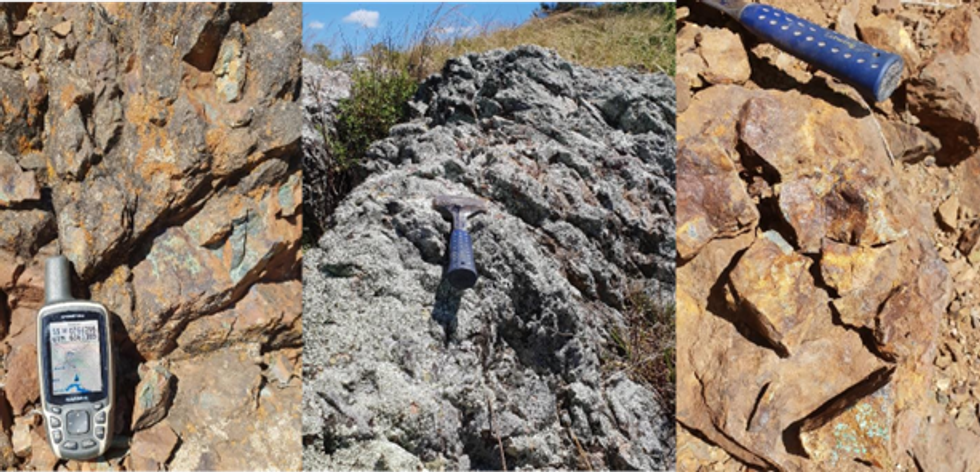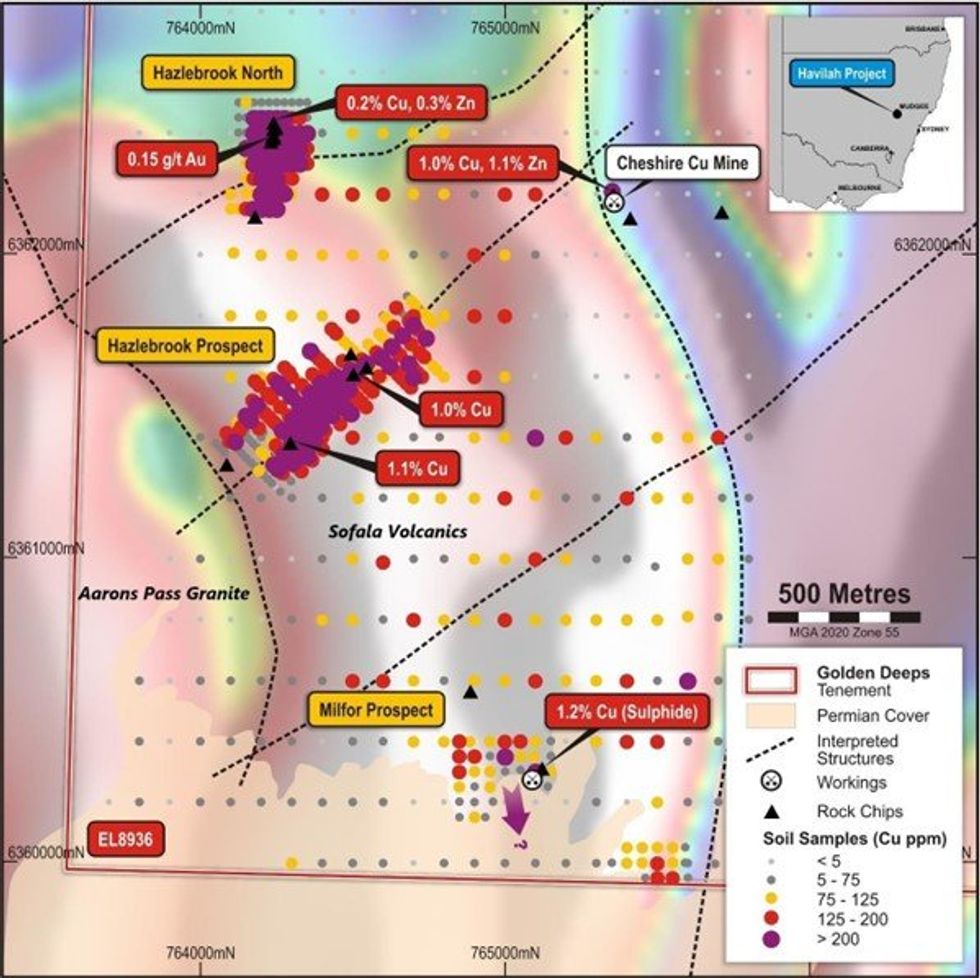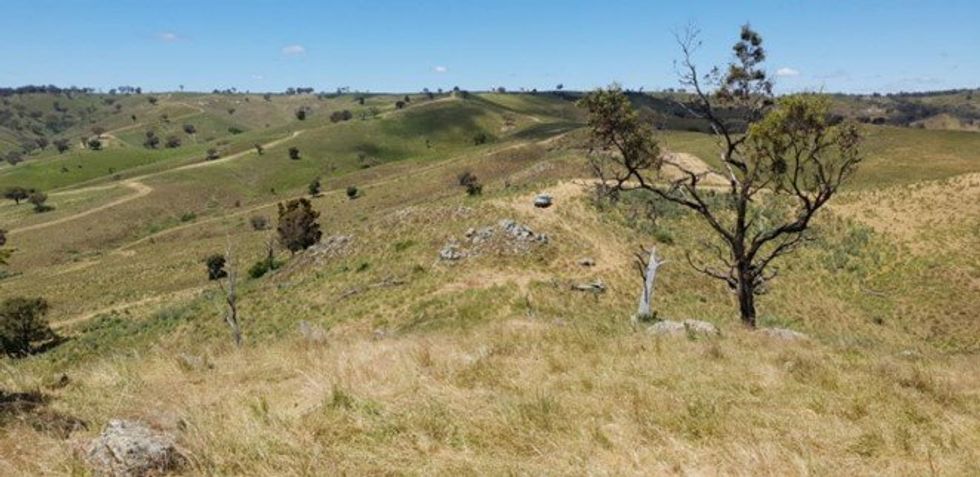
March 13, 2023
Golden Deeps Ltd (“Golden Deeps” or “the Company”) is pleased to announce further strongly copper-gold- zinc anomalous soil sampling and high-grade copper rockchip results from the Company’s 100% owned Havilah1 Project in the highly-prospective Lachlan Fold Belt copper-gold province in central NSW (Figure 1).
- Soil and rockchip sampling has identified three strongly copper mineralised target zones at the Havilah Project in the world-class Lachlan Fold Belt copper-gold province in NSW.
- High-grade rockchip results of up to 1.2% copper are associated with highly-altered and brecciated Ordovician Sofala Volcanics on the margin of the mineralised Aarons Pass Granite.
- Extensive mineralisation indicates the top of a high-level porphyry copper-gold system, with magnetics indicating the mineralisation continues under shallow Permian cover.
- Induced Polarisation (IP) geophysics is planned to target copper-gold sulphide mineralisation below the soil and rockchip anomalies and under the Permian cover. Drilling will then test key porphyry copper-gold targets analogous to the major Cadia-Ridgeway deposits to the west.
The extensive copper with gold and zinc anomalies are associated with strongly altered and mineralised Sofala Volcanics (SfV) within the magnetic aureole of the Aarons Pass Granite, which is associated with porphyry Mo-W-Cu mineralisation west of the Havilah tenement at Minrex Resources’ Mt Pleasant Project2.
The Company is targeting porphyry/volcanic hosted copper-gold mineralisation of similar style to the major Cadia-Ridgeway2 deposits in the Lachlan Fold Belt to the west of the Havilah Project (see Figure 2).
The soil and rockchip sampling (Appendix 1) has identified three highly copper anomalous zones within the Hazelbrook Prospect at the Havilah Project (see soil and rockchip results on magnetics, Figure 1, below):
i)Hazelbrook anomaly:
Infill sampling of the Hazelbrook Prospect has defined a strong, 1km x 400m, northeast-trending anomaly (Figure 1) which has also produced high-grade rockchip sample grades of up to 1.1% copper (Cu) with elevated gold (Au) and zinc (Zn). The highest grades are associated with malachite after sulphides in the altered and fractured volcanics (Image 1a) with aplitic felsic porphyry dykes.
ii)Hazelbrook North anomaly:
A very strong 400m x 200m north-south trending copper-gold-zinc anomaly (Figure 1) has been defined, which is associated with silicified and brecciated volcanics in outcrop (Image 1b). Rockchip grades of up to 0.2% Cu, 0.3% Zn and 0.15 g/t Au have been recorded, with elevated mercury - indicating a high (shallow) level in the mineralised system.
iii)Milfor anomaly:
Strong soil anomalism in altered and mineralised Sofala Volcanics has been identified, extending under Permian cover to the south (Figure 1). Chalcopyrite (copper-sulphides) in rockchips yielded grades of up to 1.2% copper (Image 1c).


Interpretation of detailed magnetics (Figure 1) indicates that the extensive copper anomalies at the Hazelbrook prospect are associated with northeast-southwest and north-south oriented faults that link to the Aarons Park Granite to the west and at depth. Aplitic porphyry dykes are also associated with these mineralised zones.
Outcropping chalcopyrite (copper-sulphide) at the Milfor prospect, in altered and brecciated Sofala Volcanics grading 1.2% Cu, indicates potential for an extensive copper sulphide system, which is partially obscured by post-mineralisation Permian sediment cover. Detailed magnetics imagery indicates that the mineralised Sofala Volcanics continue under the Permian cover to the south (Figure 1).
The Hazelbrook North anomaly, which is at a higher level topographically (see Image 2 below), appears to be the top of the porphyry system, characterised by elevated Zn-Hg-Sb in association with the Cu and Au.

IP geophysics will be carried out over the strongest soil and rockchip anomalies to detect buried porphyry/volcanic hosted copper-gold sulphide mineralisation. The IP geophysics will extend to areas where magnetics indicate a veneer of Permian sedimentary cover obscures the potentially mineralised Sofala Volcanics (Figure 1).
Following the IP geophysical survey, drilling is planned to test below the key soil and rockchip anomalies and the IP chargeability copper-gold sulphide targets.
The drilling will target copper-gold mineralisation associated with porphyry intrusives and the Ordovician Sofala Volcanics. These targets are analogous to the major Cadia-Ridgeway and North Parkes deposits, which are also hosted by Ordovician volcanics and related intrusives in parallel volcanic arcs of the Lachlan Fold Belt (LFB) that lie to the west of the Havilah Project (see location of Cadia-Ridgeway, North Parkes and the Havilah Project shown on Figure 2 below).
Click here for the full ASX Release
This article includes content from Golden Deeps Limited, licensed for the purpose of publishing on Investing News Australia. This article does not constitute financial product advice. It is your responsibility to perform proper due diligence before acting upon any information provided here. Please refer to our full disclaimer here.
GED:AU
The Conversation (0)
Latest News
Interactive Chart
Latest Press Releases
Related News
TOP STOCKS
American Battery4.030.24
Aion Therapeutic0.10-0.01
Cybin Corp2.140.00